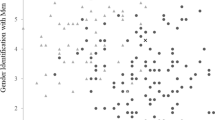Abstract
The theme of separateness and connectedness plays a central role in many schools of psychological thought. While traditional theories, such as those of Mahler in 1975 and Winnicot in 1965, conceptualize a universal development of separateness and connectedness, a number of recent theories such as those of Choderow in 1978, Gilligan in 1982, Frankenstein in 1966, Bakan in 1966, and Gutmann in 1965, propose gender differences such that males are more separated and females are more connected. The present study examined the hypothesis that men are more separated (as measured by self—other differentiation and independence) and women are more connected (as measured by empathy and desire for intimacy). Thirty men and 30 women (Israelis of western origin) responded to self-report questionnaires. Males and females were found to differ with regard to all four variables examined, such that men are more differentiated and independent, and women are more empathic and desire higher intimacy. These results are consistent with those theories that propose that males are more separate and females are more connected. The results are relevant as to the nature of the constructs themselves. The relationships between the variables defining separateness and connectedness suggest that these constructs are complex and multifaceted.
Similar content being viewed by others
References
Bakan, D. (1966). The duality of human existence. New York: Beacon Press.
Block, J. H. (1973). Conceptions of sex. American Psychologist, 28, 512–526.
Bowen, M. (1978). Family therapy in clinical practice. New York: Jason Aronson.
Campbell, D. T., Miller, N., Lubetsky, J., & O'Connell, E. J. (1968). Varieties of projection in trait attribution. Psychological Monographs, 78(15).
Carlson, R. (1971). Sex differences in ego functioning exploratory studies of agency and communion. Journal of Consulting and Clinical Psychology, 37, 267–277.
Choderow, N. (1974). Family structure and feminine personality. In M. Z. Rosaldo & L. Lamphere (Eds.), Women, culture and society. Stanford, CA: Stanford University Press.
Choderow, N. (1978). The reproduction of mothering. University of California Press.
Corcoran, K. J. (1982). An exploratory investigation into self-other differentiation: Empirical evidence for a monistic perspective on empathy. Psychotherapy: Theory, Research and Practice, 19, 63–68.
Dinnerstein, D. (1976). The mermaid and the minotaur. New York: Harper & Row.
Douvan, E., & Adelson, J. (1966). The adolescent experience. New York: John Wiley and Sons.
Eisenberg, N., & Lennon, R. (1983). Sex differences in empathy and related concepts. Psychological Bulletin, 94, 100–131.
Elitzur, A., & Rosenheim, E. (1982). Empathy and attitudes among medical students: The effect of group experience. Journal of Medical Education, 57, 675–683.
Erikson, E. (1957). Identity and the life cycle. Monograph. Psychological Issues. New York: International Universities Press.
Erikson, E. (1959). Childhood and society (2nd ed.). New York: International Universities Press.
Fairbain, W. R. D. (1952). An object-relations theory of the personality. New York: Basic Books.
Ferencz, M. (1985). The influence of defensiveness on emotional and cognitive empathy. Unpublished master's thesis, Hebrew University of Jerusalem.
Frankenstein, C. (1966). The roots of the ego. Baltimore, MD: Williams and Wilkins.
Gilligan, C. (1982). In a different voice: Psychological theory and women's development. Cambridge, MA: Harvard University Press.
Greer, G. (1972). The female eunuch. New York: Bantam Books.
Gutmann, D. L. (1965). Women and the conception of ego strength. Merrill-Palmer Quarterly, 11, 229–240.
Hess, R. D. & Handel, G. (1959). Family worlds. Chicago: University of Chicago Press.
Jackson, D. N. (1967). Personality Research Form manual. New York: Research Psychologists Press.
Karpel, D. (1976). Individuation: From fusion to dialogue. Family Process, 15, 65–82.
Kohut, H. (1980). Summarizing reflections. In A. Goldberg (Ed.), Advances in self psychology, New York: International Universities Press.
Kusyszyn, I. A. (1968). A comparison of judgmental methods with endorsements in the assessment of personality traits. Journal of Applied Psychology.
Laing, R. D. (1965). The divided self. Middlesex, England: Penguin Books.
Layton, M. (1984). Tipping the therapeutic balance—Masculine, feminine or neuter. Networker pp. 21–25.
Leupnitz, D. (1988). The family interpreted. New York: Basic Books.
Maccoby, E. E., & Jacklin, C. N. (1974). The psychology of sex differences. Stanford, CA: Stanford University Press.
Mahler, M., Pine, F., & Bergman, A. (1975). The psychological birth of the human infant. New York: Basic Books.
McDermott, J., Robillard, A. B., Char, W. F., Hsu, J., Tseng, W., & Ashton, G. (1983). Reexamining the concept of adolescence: Differences between adolescent boys and girls in the context of their families. American Journal of Psychiatry, 140, 1318–1322.
Mehrabian, A., & Epstein, N. (1972). A measure of emotional empathy. Journal of Personality, 40, 525–533.
Miller, J. B. (1976). Toward a new psychology of women. Boston: Beacon Press.
Millet, K. (1970). Sexual politics. New York: Ballantine Books.
Minuchin, S. (1974). Families and family therapy. Cambridge, MA: Harvard University Press.
Mitchell, J. (1974). Psychoanalysis and Feminism, Middlesex, England: Penguin Books.
Polster, S. (1983). Ego boundary as process: A systemic-contextual approach. Psychiatry, 46, 247–258.
Schaefer, M. T., & Olson, D. H. (1981). Assessing intimacy: The PAIR inventory. Journal of Marital and Family Therapy, 7, 640–653.
Winnicot, D. W. (1965). The maturational process and the facilitating environment. London: The Hogarth Press.
Author information
Authors and Affiliations
Additional information
This paper is based on an M.A. thesis written by the first author and supervised by the second and Dan Davis.
Rights and permissions
About this article
Cite this article
Lang-Takac, E., Osterweil, Z. Separateness and connectedness: Differences between the genders. Sex Roles 27, 277–289 (1992). https://doi.org/10.1007/BF00289929
Issue Date:
DOI: https://doi.org/10.1007/BF00289929




